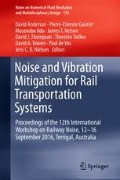Abstract
As the construction of high-speed railway in China is increasingly completed, noise pollution along the railway has gained serious attention. Noise barriers play an important role in reducing high-speed railway noise and are widely used around the world. Researchers from Germany, France, Japan, England and America have enriched the structures, theories and prediction models of high-speed railway noise barriers for the past several decades (Yin et al., J Railway Energy Saving Environ Prot Occup Safety Health 5(4):148–151, [1]). The development of noise reduction theories for barriers has three main stages: geometric and wave acoustics theory, empirical and semi-empirical theories, and finite element and boundary element theories (Wu, J Sound Vib 6(3):85–88, [2]). The Chinese criteria “Technical guidelines for environment impact appraisal, Acoustic environment” (Technical guidelines for environment impact appraisal, Acoustic environment, [3]) and “The specifications for noise barriers’ acoustical design and measurement” (The specifications for noise barriers’ acoustical design and measurement, [4]) provide the formulae for predicting the an infinitely long noise barrier’s insertion loss. According to the noise source distribution of the high-speed train, East China Jiaotong University established a formula for predicting the insertion loss of the high-speed railway noise barriers (Lei, China Railway Sci 26(4):1–4, [5]). Southwest Jiaotong University established a finite element model to estimate the insertion loss based on finite element theory and results of a high-speed train’s noise source identification (NSI) (Zhou et al., J Mech Eng 49(10):14–10, [6]). To lay a solid technical foundation for further research, comprehensive investigations and measurements of the application effect of high-speed railway noise barriers are necessary. According to the data obtained from integration tests and commissioning in recent years, noise reduction effects of noise barriers with different materials and heights, and noise measurement points at different positions are summarized (Gu et al., J Energy Sav 5(4):143–147, [7]). Regarding the high-speed railway noise as an equivalent line noise source, the insertion loss formulas from “Technical guidelines for environment impact appraisal, Acoustic environment” and “The specifications for noise barriers’ acoustical design and measurement” are verified by test data, and the height of the equivalent line noise source of the train moving at 300 km/h is suggested at 2 m from the bottom of the barrier. Furthermore, the prediction of the barrier’s insertion loss is more accurate by separating the noise sources into different lines based on the primary results of NSI.
Access this chapter
Tax calculation will be finalised at checkout
Purchases are for personal use only
References
Yin, H., Liu, L.H., Li, Y.L., et al.: The research status and development trend of China’s high-speed railway noise barrier. J. Railway Energy Saving Environ Prot Occup Safety Health 5(4), 148–151 (2015). (in Chinese)
Wu, H.Y.: Advances on insertion loss theory of road barrier. J. Sound Vib. 6(3), 85–88 (2006). (in Chinese)
Technical guidelines for environment impact appraisal, Acoustic environment. HJ2.4-2009 (in Chinese)
The specifications for noise barriers’ acoustical design and measurement. HJ/T 90-2004 (in Chinese)
Lei, X.Y.: Calculation method for high-speed railway noise. China Railway Sci. 26(4), 1–4 (2005). (in Chinese)
Zhou, X., Xiao, X.B., He, B., et al.: Numerical model for predicting the noise reduction of noise barrier of high speed railway and its test validation. J. Mech. Eng. 49(10), 14–19 (in Chinese)
Gu, X.A., Guo, H.Y., Zhou, T.J., et al.: The research and development survey of railway sound barrier in China. J. Railway Energy Saving Environ Prot Occup Safety Health 5(4), 143–147 (2015). (in Chinese)
Zhang, L.J., Zhang, B., Hu, W.C., et al.: The comparative analysis of theory and measurement about the protective effect of additional length of the high-speed rail sound barrier. Sound Vib. Control 34(s1), 75–77 (2014). (in Chinese)
Su, W.Q., Pan, X.Y., Ye, P.: The study of acoustic computing model for the noise barrier of high-speed railway. China Railway Sci. 34(1), 126–130 (2013). (in Chinese)
Author information
Authors and Affiliations
Corresponding author
Editor information
Editors and Affiliations
Rights and permissions
Copyright information
© 2018 Springer International Publishing AG, part of Springer Nature
About this paper
Cite this paper
Li, Y., Li, Z. (2018). Application Effect of Chinese High-Speed Railway Noise Barriers. In: Anderson, D., et al. Noise and Vibration Mitigation for Rail Transportation Systems. Notes on Numerical Fluid Mechanics and Multidisciplinary Design, vol 139. Springer, Cham. https://doi.org/10.1007/978-3-319-73411-8_32
Download citation
DOI: https://doi.org/10.1007/978-3-319-73411-8_32
Published:
Publisher Name: Springer, Cham
Print ISBN: 978-3-319-73410-1
Online ISBN: 978-3-319-73411-8
eBook Packages: EngineeringEngineering (R0)

